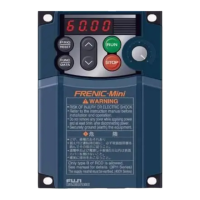Protective Functions
Protective Functions
Function
Overcurrent
Protection
Overvoltage
protection
Undervoltage
protection
Input phase loss
protection
Inverter
Braking resistor
Overload protection
Electronic
thermal
overload relay
Motor protection
Overheat
protection
Overload early
warning
External alarm input
Alarm relay output
(for any fault)
Memory error
Remote keypad
communication error
CPU error
Output phase loss protection
RS-485 communication error
•
Stops the inverter output to protect the inverter from an overcurrent resulting from overload.
•
Stops the inverter output to protect the inverter from an overcurrent due to a short-circuit in the output circuit.
•
Stops the inverter output to protect the inverter from an overcurrent due to a ground fault
in the output circuit. This protection is effective only when the inverter starts. If you turn
on the inverter without removing the ground fault, this protection may not work.
Detects input phase loss, stopping the inverter output. This function prevents the inverter from undergoing heavy stress
that may be caused by input phase loss or interphase voltage unbalance and may damage the inverter.
If connected load is light or a DC reactor is connected to the inverter, this funtion will not detect input phase loss if any.
In single-phase series of inverters, this function is disabled by factory default.
•
Stops the inverter when it detects excess heat sink temperature in case of cooling fan failure or overload.
•
When the built-in or external braking resistor overheats, the inverter stops running.
*
It is necessary to set the function code corresponding to the braking resistor used (built-in or external).
Calculates the IGBT internal temperature from the output current and internal temperature detection, stopping the inverter.
The inverter stops running the motor to protect the motor in accordance with the electronic thermal
function setting.
• Protection of a standard motor over the entire frequency range.
• Protects the inverter motor over the entire frequency range.
* The operation level and thermal time constant can be set.
• Stops the inverter with an alarm through the digital input signal (THR).
If the inverter detects a CPU error caused by noise or some other factor, the inverter stops.
On detecting an RS-485 communication error, the inverter displays the error code.
Detects breaks in inverter output wiring at the start of running and during running, stopping the inverter output.
The inverter checks memory data after power-on and when the data is written. If a memory error is detected, the inverter stops.
The inverter stops by detecting a communication error between the inverter and the remote keypad
(option) during operation from the remote keypad.
• The inverter outputs a relay contact signal when the inverter issues an alarm and stopped.
<Alarm reset>
The alarm stop state is reset by pressing the key or by the digital input signal (RST).
<Saving the alarm history and detailed data>
The information on the previous 4 alarms can be saved and displayed.
Outputs a preliminary alarm at a preset level before the inverter is stopped by the electronic thermal
function for the purpose of protecting the motor.
Stall prevention
Operates when the instantaneous overcurrent hits the set limit.
Instantaneous overcurrent limit: Operates if the inverter output current exceeds the instantaneous overcurrent
limit to prevent the inverter from tripping (during acceleration or negative constant speed operation).
PTC thermistor
• A PTC thermistor input stops the inverter to protect the motor.
A PTC thermistor is connected between terminals C1 and 11, and a 1kΩ external resistor is
connected between terminals 13 and C1.
During acceleration
During deceleration
While running at
constant speed
Operation error STOP key
priority
Start check
function
Pressing key on the keypad forces the inverter to decelerate and stop the motor even
if the inverter is running by any run commands given via the terminals or communications
(link operation). After the motor stops, the inverter issues alarm " ."
Inverters prohibit any run operations and displays " " on the LED of keypad if
any run command is given when:
• Powering up
• Releasing an alarm (
key turned on)
• Link command (LE) has switched inverter operations
-
-
During acceleration
During deceleration
While running at constant
speed(Stopped)
-
-
-
Description
LED
monitor
F14
H98
H43
H26,H27
E34,E35
F50,F51
H12
E01 to E03
E98, E99
E20,E27
E01 to E03
E98,E99
F02
H96
H98
Related
function code
Alarm output
(30A,B,C) Note)
Data save error
during undervoltage
If the data could not be saved during activation of the undervoltage protection function, the inverter
displays the error code.
F10
F11,F12
Note) A in the alarm output (30A,B,C) column indicates that there are cases where an alarm is not output in accordance with the function code.
The inverter stops the inverter output upon detecting an overvoltage condition
(400V DC for three-phase 230 V, single-phase 230 V, and single-phase 115 V
class series; 800 V DC for three-phase 460 V class series) in the DC link bus.
This protection is not assured if excess AC line voltage is applied inadvertently.
Stops the inverter output when the DC link bus voltage drops below the undervoltage level (200 V
DC for three-phase 230 V, single-phase 230 V, and single-phase 115 V class series; 400 V DC for
three-phase 460 V class series).
However, if data "4 or 5" is selected for F14, no alarm is output even if the DC link bus voltage drops.
24

